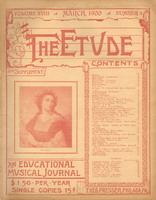BY THEODORE STEARNS.
Wagner and the White Elephant.
One of Hermann Ritter’s favorite anecdotes about Richard Wagner comes from the time when, the requisite sum still unraised to complete the Beyreuth theatre, Wagner had sent for Ritter to play first viola in his orchestra when everything should be ready for the first festival. Wagner was talking disconsolately with the originator of the viola alta when Leopold Damrosch came up.
“Oh, for more money,” Wagner was saying. “We must have it, we need it.”
With his customary deference, Damrosch said: “There is all you need in America, Meister. There, there are hundreds of people ready to aid you. Why, if you would but go there, a million dollars would be yours.”
“What!” shouted Wagner, in a fine rage. “Do you think I am a white elephant? I’m not a show—no white elephant. Do you think I would do such a thing?”
Damrosch was struck speechless, but in after years Ritter, gray-haired, but bristling with vivacity, told his musical-history classes the story, dwelling on the scene with characteristic humor, one lank leg swinging from the corner of a table and both hands shoved deep in trousers’ pockets.
* * *
Strauss and Mascagni.
When Richard Strauss came to Würzburg several years ago to direct his “Till Eulenspiegel” at a concert given in the Schrannen, he was joined by Max Meyer-Obersleben and several other professors of the Würzburg Royal Music School after the concert, and the conversation drifted along the highway of modern composition until, among various other topics, the name of Pietro Mascagni was mentioned.
Now Strauss, who holds the slightest mistake in composition in sublime contempt, and being himself a past-master in the art of clothing musical ideas in picturesque contrapuntal devices, cannot bear to hear the slightest allusion to Mascagni.
Instantly he was all afire, and straightening himself, snorted out: “What! that youngster. Don’t talk to me about him. There is only one place for him. No; it’s not an insane asylum,” he said, swiftly. “He ought to be put in a conservatory and be made to learn how to instrumentate. ‘Cavalleria,’” he growled; “one ought to call that Caviar-aria.”
This twist of the word into a dig both at Mascagni and the Russian delicacy which Strauss detests was relished hugely by Meyer-Obersleben, who loves a good play on words, and when a year or so afterward he related it to me his eye twinkled in broad laughter. But a few days later we were looking over the score of “Engelspiel.” All trace of the caviar jest had passed beyond the recollection of the worthy professor as he gazed helplessly at the score before him. “Look at that passage for the horns,” he exclaimed. “There’s no rule on earth that can help us out. Herr Gott! the fellow risks a terrible lot. Of course it’s only meant for a patch of tone-color, but, three seconds in succession!”
It is interesting to know that Meyer-Obersleben’s new opera, “Die Hauben-Krieg,” has been accepted by Possart, the intendant of the Munich Court Theatre. The fact that this opera is strictly comic, not unlike Wagner’s “Meistersinger,” is none the less awe-inspiring to the pupils of the Würzburg Music School, whom no power on earth could convince that the scowling pedagogue of the counterpoint and harmony classes could ever relax into a smile, or, engrossed with a scene from the “Hauben-Krieg,” could howl and pound the piano with the terrific earnestness of a Beethoven or shriek in delight at some comic by-play in his opera with the unconscious abandon of an Artemus Ward.



